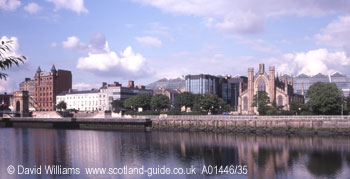The River Clyde is Scotland`s third longest river and it flows about 160km (100 miles) from the Lanarkshire hills to the town of Greenock, falling some 600m (2000 feet) on its journey downstream; thereafter, the river turns southwards and becomes the Firth of Clyde. The river sits in a broad valley and altogether it drains an area of about 4000 square kilometres (1600 square miles) with its main tributaries in Glasgow being the River Kelvin and the White Cart Water.
Glaswegians would certainly claim it to be the country`s most important
river as it flows through the most densely populated area of Scotland
and because it has been closely connected with many of the country`s industries.
Glasgow is situated at an important crossing point where a busy ford and
bridge were established long ago, but the original significance of the
medieval city depended on Glasgow Cathedral, not the river, and the well-known
phrase Glasgow made the Clyde and the Clyde made Glasgow reflects
the role of the river in more recent centuries.
This article is based on the guidebook "The Glasgow Guide".

The Roman Catholic Cathedral is on the right of the picture, with the huge glass roof of the St Enoch shopping centre behind it.